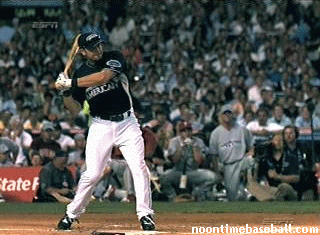fanboi22
on the journey
I had jumped the topic in the Double Pendulum thread, so thought I would start this new one.
It seems like this has been debated in the past (see snf thread) but am really curious if there is data proving there really is early bat speed and/or what the definition of early bat speed is if it is not actually increased speed of the barrel relative to the hand speed at the start of the swing.
I am of the mind that the initiation of the swing is getting the correct tilt and hand path on plane to the pitch having the torso pull the hands which are held tight to the same relative position about the torso as it tilts and turns creating bat lag (not early bat speed) with little to no more bat speed v hand speed until the hands move from the torso in a line to the ball and whip into contact(Longoria gif).
That is what I see from the Ortiz data and the Longoria gif. In the skeleton gif you can see when the speed of the barrel increases and goes to green as the end of the barrel is facing the catcher behind the batter.
I have tried with my DD to torque the barrel to get early bat speed which it did, but it also dumped the barrel below the path and lowered the overall speed of the swing and eliminated alot of the power.
So my question is, is there data that supports early bat speed which has the barrel traveling faster than the hands early in the swing and maintaining or increasing that speed thru contact? IMO if there is bat lag which leads to release and whip of barrel, there cannot be the 'early bat speed'. Perhaps I am misunderstanding the definition of early bat speed.

It seems like this has been debated in the past (see snf thread) but am really curious if there is data proving there really is early bat speed and/or what the definition of early bat speed is if it is not actually increased speed of the barrel relative to the hand speed at the start of the swing.
I am of the mind that the initiation of the swing is getting the correct tilt and hand path on plane to the pitch having the torso pull the hands which are held tight to the same relative position about the torso as it tilts and turns creating bat lag (not early bat speed) with little to no more bat speed v hand speed until the hands move from the torso in a line to the ball and whip into contact(Longoria gif).
That is what I see from the Ortiz data and the Longoria gif. In the skeleton gif you can see when the speed of the barrel increases and goes to green as the end of the barrel is facing the catcher behind the batter.
I have tried with my DD to torque the barrel to get early bat speed which it did, but it also dumped the barrel below the path and lowered the overall speed of the swing and eliminated alot of the power.
So my question is, is there data that supports early bat speed which has the barrel traveling faster than the hands early in the swing and maintaining or increasing that speed thru contact? IMO if there is bat lag which leads to release and whip of barrel, there cannot be the 'early bat speed'. Perhaps I am misunderstanding the definition of early bat speed.


